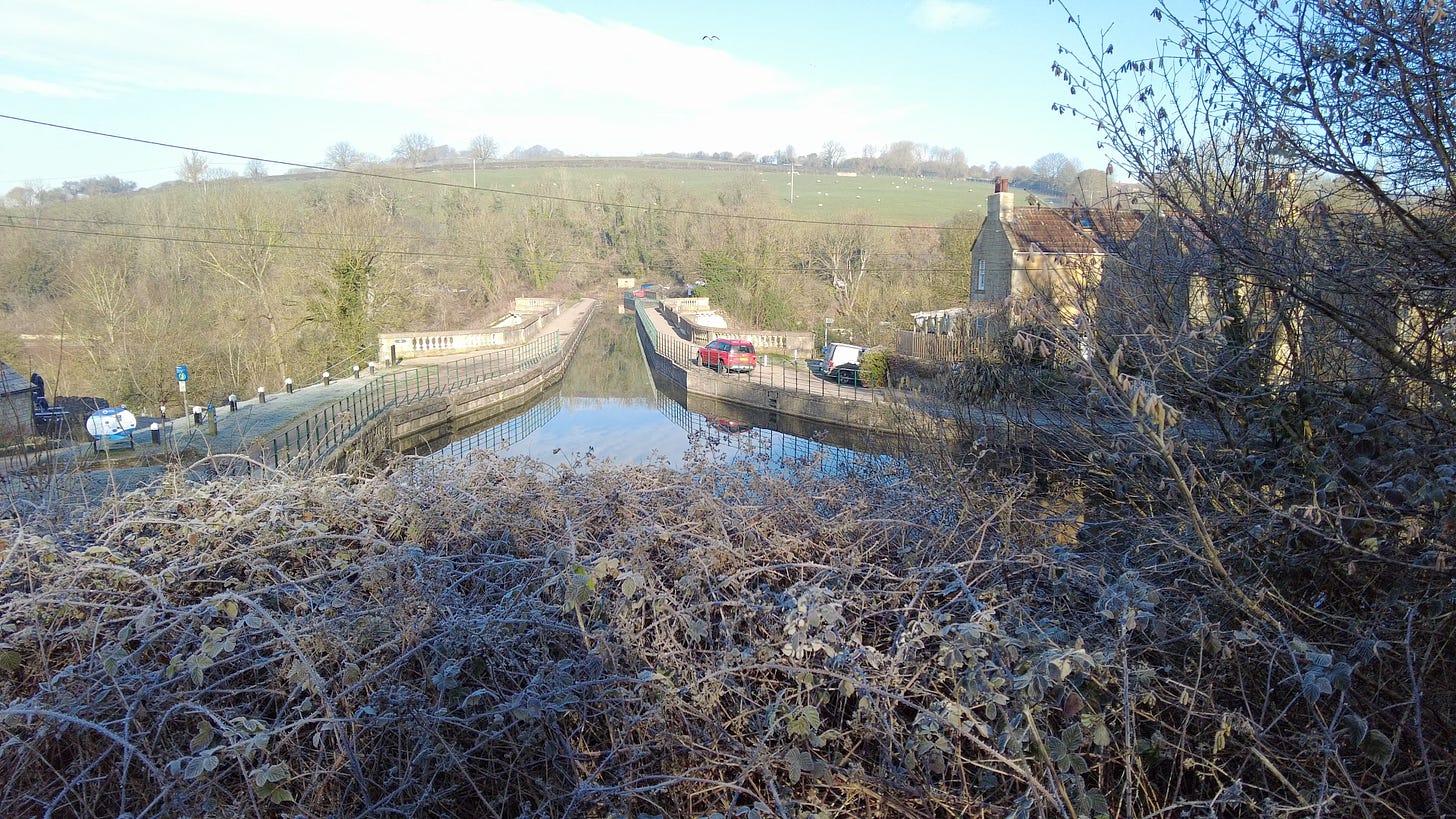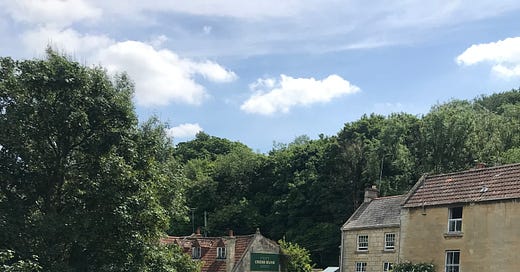
There can be few places so small and yet have a mainline railway station, river, canal and a renowned aqueduct than Avoncliff. Let’s explore this tiny village together, see its wonderful old buildings, and learn about its past.
Avoncliff originates from the name of the river it straddles, The Avon (Celtic word for river) and the steep sides of the Avon Valley leading up to the village of Westwood. Named Avoncliffe in the reign of King Henry ll (1133-1189), and appeared later in various forms; Ankly, Anclift and Ancliff.
Mills were built along the River Avon, and we will look at the history of two of those later. The village is under two miles west of the lovely town of Bradford on Avon. You will find many people walking and cycling along the towpath of the Kennet and Avon Canal from Bradford on Avon to see the Aqueduct. Many narrowboats are using the restored canal, with both holiday makers and canal dwellers making it a busy waterway.
I parked my car in Upper Westwood, and walked along the footpath to reach the road. This is a steep hill to traverse and going up is a good heart and lung workout!
I start my exploration from the towpath on the Kennet and Avon Canal Aqueduct, which crosses the River Avon and the railway tracks at the bottom of the valley well below me. My vantage point enables me to look eastwards towards Bradford on Avon. Lying below me is the railway station, which opened on July 9th 1906. The railway track from Bristol to the Dorset coastal town of Weymouth was laid in 1857, and was originally broad gauge, Brunel’s preferred track width. It was later changed to the standard gauge.
The Mill on the Winsley (north) side of the River Avon
The river noisily flows over a weir at this point, and on the north side (Winsley side) is one of the former mills, now converted to a home; see the photo below.
A mill was certainly here in 1249 when a boy named David was killed by the waterwheel. A miller is mentioned at this mill in 1439, showing its continuous use. The mill was eventually switched from flour to producing flock and shoddy from recycled clothing in tandem with Westwood Mill built on the opposite side of the river. The mill burned down in 1883 and was completely rebuilt.

After the 1939–45 war, the mill was first used to manufacture chlorophyll and, later, firelighters. It eventually closed and stood empty for many years. It has been undergoing extensive restoration to convert it into a private home.
The Mill on the Westwood (south) side of the River Avon
This mill also burned down a few years later, in 1901. It was restored and reduced from four floors to two.
It’s possible that this mill was one of two listed in the Domesday Book (1086), paying ten shillings a year tax and belonging to Winchester Cathedral, over sixty miles away. It possibly became known as South Mill or Daniels Mill. The free-standing chimney next to the Cross Guns Pub belongs to the mill.
Like the one on the opposite side of the river, this mill had a tragedy concerning a young boy. The lad was William Gibbence, age 12. In December 1791, an inquest was held following William’s death.
The report states:
“William, who with many others, younger as well as older, was employed at Ancliffe Mill in Westwood in managing and working the late improved machines and engines for cloth making, and having inadvertently, in his playtime, buckled one part or end of a long strap of leather round his waist the other end was taken hold of by a large upright piece of timber, called the mainshaft, constantly going round, turning and working the engines, whereby he was whirled round with great force, his body bruised, his limbs shattered and beaten off, so that he was instantly dead”.
After closure, I believe to be after the second world war, it became a tea garden and had boat rides along the River Avon. In 1998 it was converted into a house and is now known as Weavers Mill.
Avoncliff Aqueduct
The aqueduct was the work of the famous canal engineer John Rennie and his chief engineer, John Thomas. It was built between 1797 and 1801. The aqueduct comprises three arches and is 110 yards long as it spans the River Avon and the railway line. The central arch has a sixty-foot span, and the two sides arches are both thirty-four feet across.

The aqueduct has a design flaw, as the central section has proven. Since it was built, the central section of the aqueduct has sagged several times under the weight of the water and has required repairs. Visitors can see the most recent repair work, seen in the different colours of stone, undertaken in 1980 during the restoration to reopen the Kennet and Avon canal. A concrete trough was built into the aqueduct to reduce the pressure on the central section and prevent further sagging.


The aqueduct attracts many visitors and is popular with walkers and cyclists as the towpath alongside the Kennet and Avon Canal is National Cycling Route number 4.
The Cross Guns Pub Avoncliff
The pub in Avoncliff has stood for centuries. The twin-gabled section of the building is believed to date back to the 1490s. The central inglenook fireplace is built in the same style as one in Hampton Court, the building of which began in 1514. The east wing was constructed in the early 1600s, and it became known as The Carpenters Arms. Before the aqueduct's opening, anyone wishing to cross the River Avon had to use the ford. During heavy rain when the river is in full flow that would have been impossible or very dangerous. A combination of beer and water might have been a step too far!
The construction of the canal brought trade to the pub and called for the building of an extension on the west side. Records discovered reveal that the landlord of The Barge Inn upstream at Bradford on Avon regularly brought “ladies of the town” to the Carpenters Arms to warm the spirit of the bargemen! Bargees would also challenge each other, no doubt after one too many, to climb up the inside of the chimney. Other rascals would then stoke the fire to keep them up there. Imagine an evening out at the pub in those days, or perhaps not.
In 1794 the 9th Battalion of the Wiltshire Rifle Volunteers was formed and established a rifle range beside the pub. The pub was renamed The Cross Guns to honour the regiment.
Ancliff Square
Lying on the west side of Avoncliff is Ancliff Square, which comprises twelve private homes. It was most likely built in the 1790s to accommodate apprentice workers at the woollen cloth mills. In 1835 it was converted to become the workhouse of the Bradford Poor Law Union. The 1851 census recorded that on March 30th there were 249 occupants of the Bradford Work House – 13 officers and 236 paupers.
In 1917 it become necessary to convert it into a Red Cross Hospital to look after those soldiers injured in the Great War.
A little later, in 1923 it became The Old Court Hotel until the second world war arrived and it was requisitioned and used as the offices for the British Museum. Many valuable items were stored in the tunnels of the quarry in the Westwood hillside which looks down on Ancliff Square. The hotel closed its doors in 1948.
The hotel lay empty until 1952 when it was purchased by the Dell family and converted into 14 flats. The Dell’s sold the property circa 1967, and after a few ownership changes it was decided to convert them back to twelve houses based on the original weavers’ cottages and sell them.
Mill Cottage and The Pumping Station


Walking from the railway station side of the aqueduct, the road takes you to Bradford on Avon. Just a few yards along the road you will come to Mill Cottage on your right which was once the home of the manager of the mill on the north side of the river. The railway line runs only yards from the house and divides the mill from the house, with what in 1857 would have been a broad gauge track.
The pumping station for Bradford Water Works, built in 1883, pumped water from a well and adits in the hillside up to the main reservoir on Bradford Road, Winsley.
The Avoncliff Tramway and Stone Yard
The stone from the quarry at Westwood (much of which was mined) a tramway was built to load stone onto the barges and the trains. Over the river, at Winsley, several tramways were used to get the stone down to the Kennet and Avon Canal.

The map above shows the tramway route; it passed over the west side of the aqueduct, turning left onto the stone yard. The stone yard remained in use until after WW2.
The photograph above shows the track of the tramway which was gravity powered and once at the bottom of the hill would be pulled by horses. You can see the mine entrance at the top of the tramway. A small industrial development is now located here. Although quarrying ceased, sometimes stone is extracted when an exact match is needed. The stone is flecked with rusty patches making it different from other stone quarried.
I don’t know the date of this photograph, but the garden to the right of the track is what we now know as Ancliff Square.
Time for Tea? No 10 Tea Garden at Avoncliff
If you are in need of refreshments, not only does Avoncliff have the Cross Guns, it also has the delightful and award-winning, No 10 Tea Garden.
How to get to Avoncliff
If you are driving to Avoncliff, please note that there is a pay-and-display car park on the Westwood side. It is accessed from a narrow lane leading from Upper Westwood. On the opposite side of the river, there is a small space for free parking, but it is nearly always taken. If you can walk a reasonable distance, the towpath from Bradford on Avon or the walk alongside the river is very pleasant. You can also walk from Winsley or Westwood with a selection of footpaths and road combinations.
What3Words for the Avoncliff car park is dolly.enacted.luckier
I hope you have enjoyed this exploration of Avoncliff, and if you do get the chance to visit it is well worth while. I made a video of Winsley, the village looking down on Avoncliff from the north side. Click here to watch.










